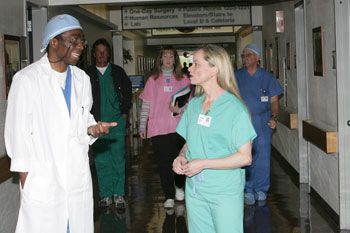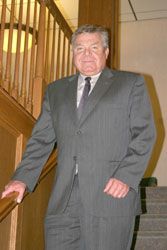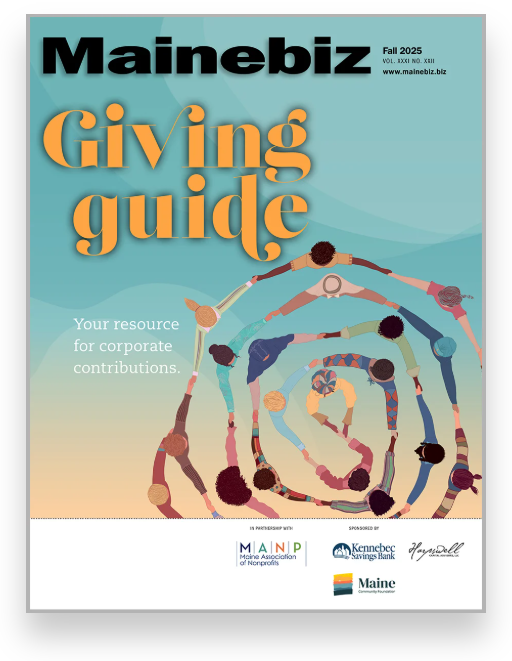Processing Your Payment
Please do not leave this page until complete. This can take a few moments.
- News
-
Editions
-
- Lists
-
Viewpoints
-
Our Events
-
Award Honorees
- 2025 Business Leaders of the Year
- 2025 Outstanding Women in Business
- 2024 40 Under 40 Honorees
- 2024 Women to Watch Honorees
- 2024 Business Leaders of the Year
- 2023 NextUp: 40 Under 40 Honorees
- 2023 Women to Watch Honorees
- 2023 Business Leaders of the Year
- 2022 NextUp: 40 Under 40 Honorees
- 2022 Women to Watch Honorees
- 2022 Business Leaders of the Year
-
-
Calendar
-
Biz Marketplace
- News
-
Editions
View Digital Editions
Biweekly Issues
- September 22, 2025
- September 8, 2025
- August 25, 2025
- August 11, 2025
- July 28, 2025
- July 14, 2025
- + More
Special Editions
- Lists
- Viewpoints
- Our Events
- Calendar
- Biz Marketplace
From the mailroom to the corner office | Employees who spend their careers at a single company are a dying breed. But some Mainers are still living the one-company life.
 Photo/Kim Griffeth
From RN to CEO: Kris Doody started at Cary Medical Center as a candy striper. Now, she's the hospital's top executive.
Photo/Kim Griffeth
From RN to CEO: Kris Doody started at Cary Medical Center as a candy striper. Now, she's the hospital's top executive.
 Photo/Courtesy Machias Savings Bank
CEO Ed Hennessey started as a teller at Machias Savings Bank in 1970
Photo/Courtesy Machias Savings Bank
CEO Ed Hennessey started as a teller at Machias Savings Bank in 1970
One night last spring, CEO Kris Doody emerged from an evening staff meeting at Cary Medical Center in Caribou and took her customary stroll through the hospital’s hallways before heading home.
On this particular night, however, she didn’t leave the hospital until morning.
Instead, Doody found the inpatient unit was overrun and Cary Medical’s nurses were scrambling to handle the rush. Without a second thought, Doody, a former nurse, rushed to her office, changed into her hospital scrubs and headed back to the unit to spend the night starting IVs and dispensing medication to patients.
Pinch-hitting at any level of her company is second nature for Doody, 45, a Caribou native who has spent her career at Cary Medical Center climbing the corporate ladder since she was a 14-year-old candy striper. In 1996, Doody was offered the job of CEO. She now oversees roughly 500 employees and an annual budget of $90 million.
But leaders like Doody who grew up within the company they now lead are rapidly becoming an endangered species. In 2007, 19% of CEOs at S&P 500 companies had worked at their company their entire career, compared with 26% in 2000, according to a recent study by Spencer Stuart, an executive search consulting firm in Chicago. Not only are executives job-hopping, they’re doing so at a faster clip, according to a study from Virginia-based consulting firm Booz Allen Hamilton that looked at CEO turnover at the world’s largest 2,500 publicly-traded companies. The annual rate of CEO turnover increased 59% between 1995 and 2006, according to that study.
The one-company employee “is a dying breed,” says Stephen Bailey, president of the National Management Association, a professional leadership development organization in Dayton, Ohio. “And I’m not sure that’s wise.”
In rural Maine, where jobs are scarce, one-company leaders remain commonplace, while southern Maine appears to reflect the national trend toward fresh faces in the executive suite. Deciding which circumstance is better depends on your perspective.
Movin’ on up
The strengths of a one-company leader are clear: People who have dedicated their professional life to one organization have ingrained values that often are the essence of a company. For example, Peter Vigue, who was hired by The Cianbro Cos. in Pittsfield as a general laborer in 1970 and became its president in 1990 and its CEO in 2000, still espouses lessons the founders of the company, his mentors the Cianchette brothers, learned from their Italian immigrant father: treat people with dignity and respect, your word is your bond, give back to that “from which you take.” Vigue’s dedication to the company appears to have served it well — Cianbro now employs roughly 2,500 people and operates in 15 states. Vigue recently passed the president’s torch to his son, Peter “Andi” Vigue, though the elder Vigue remains CEO of Cianbro.
A long-serving employee also has had time to build working relationships with employees based on mutual respect rather than titles and hierarchy, and can make decisions informed by an intimate knowledge of past decisions, good or bad, made by predecessors. “I do think your leadership is formed by your experiences,” says Ellen Belknap, president of the Portland architecture and engineering firm SMRT, where she began as a summer intern in 1983.
Larry Shaw’s 26-year history with MMG Insurance in Presque Isle influences decisions he makes every day as the company’s president and CEO. Shaw began in 1982 as a trainee in a line of insurance that hadn’t yet been totally developed. The first two years, he worked in the mailroom, pulling staples from piles of policies to be keyed into the company’s system. From there, he worked his way up the ladder: He was promoted to staff underwriter in 1985; assistant underwriting manager in 1986; assistant secretary, an officer of the company, in 1988; assistant vice president in 1990; vice president and chief operating officer in 1991; executive vice president and acting CEO in 1994; and president and CEO in 1995.
“I think I have a very good understanding of what goes on at all levels of our organization,” Shaw says, adding that as an employee of MMG he’s witnessed great and poor decisions alike. “Over time, your experience just builds an intuition for how the business is done. I don’t think you can replace that in your decision-making.”
While an intimate knowledge of every facet of an organization can be a plus, there are downsides to a one-company employee that many people interviewed for this story acknowledge. One danger Bailey sees — especially, he says, in nonprofit organizations — is that longtime employees begin to feel a false sense of ownership over the company, “and that’s not good.” A leader who has spent his entire career with the same organization can also suffer from “tunnel vision,” Bailey says. “It’s very easy to say, ‘We’ve always done it this way.’” That attitude in the face of changes posed by globalization and increased competition can be fatal to a business, Bailey says.
Ed Hennessey, who was hired as a teller at Machias Savings Bank in 1970 and became its president and CEO in 1986, admits being a leader without experience outside the organization can be seen as a weakness. But for him, his long history with the bank has given him the opportunity to build a management team he believes makes up for the outside experience he lacks. Hennessey’s senior management team includes a former teacher, a former accountant and others who bring diverse influences to the organization. “The best way to put it,” Hennessey says, “is the leader is only as strong as the weakest member of his team.”
Goodbye, company man
Whatever the effect on the organization, there are several forces working against the one-company career. Globalism requires businesses to be more flexible, able to constrict and contract based on market forces. Gone are company pensions, which once tied employees to their employers. “One of the things happening in the economy nationwide is the retirement stuff that used to tie people to particular jobs has been reduced,” explains Jon Reisman, an associate professor of economics and public policy at the University of Maine at Machias. “You have 401(k)s that you can rollover, but they are independent of an actual job.”
Also, the generation entering the workforce now comes from a world encouraging transience, says Bailey. In school, he says these future employees are told by professors to expect to hop from job to job looking for the next opportunity for promotion, says Bailey. He says the generation entering the workforce feels entitled to frequent growth opportunities, and if those opportunities aren’t readily made available, they look elsewhere.
Bailey says that means all CEOs right now are facing a double-edged dilemma — dealing with the retirement of the baby boomers and the subsequent loss of that institutional knowledge, and trying to retain new hires with high expectations.
All these changes mean successful one-company leaders are the ones most able to adapt and grow along with the company. Belknap joined SMRT when it had six or seven employees — now there are 80. Hennessey joined Machias Savings Bank when it was a $9 million bank with four employees — now it has assets of $845 million with 120 employees. Shaw joined MMG when it had 26 employees — he’s seen it grow to roughly 150 employees. “The timing was great for me,” Shaw says. “The company started to expand and as it expanded there just was more and more opportunity for me. That always kept me quite excited about the future because I could see ahead of me that there was just going to be chances for me to enhance my career and take on more and more responsibility.”
Even one-company leaders recognize their companies need fresh blood. Executives like Doody and Belknap work to keep bright entry-level employees at their organizations for the long haul, but they also bring in talent from outside the organization. Cary Medical Center’s Doody says she looks at nurses just coming out of local nursing programs and identifies ones she believes could grow up within the organization. At the same time, she recently hired nurses from Georgia and California to bring outside experience to the team. “Striking a balance and augmenting the talent that we have locally with talent we bring in from outside our community or outside the state creates a strong team,” Doody says.
Not all executives see becoming the CEO of their company as the ultimate goal, however. After climbing the ladder to the corner office at Cary Medical Center, Doody still identifies with nurses first and administrators second. “That’s who I am,” she says. “Just a registered nurse from Caribou, Maine, who was provided the fortunate opportunity to become their hospital’s CEO.”
Whit Richardson, Mainebiz staff writer, can be reached at wrichardson@mainebiz.biz.
Family business
It may be increasingly rare in the private sector for an entry-level employee to one day become the CEO, but there's still one place it's the norm: the family-owned business. In family-owned companies, sons and daughters often grow up working in the business and never leave. But even that's changing as globalization forces businesses to be more innovative and adaptable, says Tom Juenemann, director of the Institute for Family-Owned Business at the University of Southern Maine in Portland.
Leaders of family-run businesses understand intimately the benefits of knowing the company inside and out, but they're also now looking for ways to diversify experience in the ranks, according to Juenemann: "Globalism is reshaping many aspects of business, and family businesses are responding by seeking broader levels of experience and input."
Juenemann says many family-owned businesses are requiring family members to work outside the company to gain experience before returning to the fold. "They want you to broaden yourself and see what works in other companies and bring those ideas back," he explains.
Gene Geiger started at 13 or 14 packing boxes in the warehouse or filing in the office for his father, who ran Geiger, a publisher based in Lewiston. After college he traveled for a year before returning to the family business. In hindsight, he says he would have benefitted from experience outside the family business. One of his sons is already involved with the business, but he says he hopes his younger son will gain experience outside.
Geiger recently returned from a business trip to China where he went to seek out new opportunities. His company is part of a 25-member industry group that shares information and experiences. "One tends to be oblivious to opportunities if one stays in a more sheltered or less exposed environment," Gegier says. "If one is not exposed to the best new ideas or new things coming along than one runs the serious risk of being undermined by new competitive forces that you didn't foresee."
Whit Richardson
Mainebiz web partners

The Giving Guide
The Giving Guide helps nonprofits have the opportunity to showcase and differentiate their organizations so that businesses better understand how they can contribute to a nonprofit’s mission and work.
Learn More
Work for ME
Work for ME is a workforce development tool to help Maine’s employers target Maine’s emerging workforce. Work for ME highlights each industry, its impact on Maine’s economy, the jobs available to entry-level workers, the training and education needed to get a career started.
Learn More
Groundbreaking Maine
Whether you’re a developer, financer, architect, or industry enthusiast, Groundbreaking Maine is crafted to be your go-to source for valuable insights in Maine’s real estate and construction community.
Learn more-
The Giving Guide
The Giving Guide helps nonprofits have the opportunity to showcase and differentiate their organizations so that businesses better understand how they can contribute to a nonprofit’s mission and work.
-
Work for ME
Work for ME is a workforce development tool to help Maine’s employers target Maine’s emerging workforce. Work for ME highlights each industry, its impact on Maine’s economy, the jobs available to entry-level workers, the training and education needed to get a career started.
-
Groundbreaking Maine
Whether you’re a developer, financer, architect, or industry enthusiast, Groundbreaking Maine is crafted to be your go-to source for valuable insights in Maine’s real estate and construction community.
ABOUT
NEW ENGLAND BUSINESS MEDIA SITES
No articles left
Get access now
In order to use this feature, we need some information from you. You can also login or register for a free account.
By clicking submit you are agreeing to our cookie usage and Privacy Policy
Already have an account? Login
Already have an account? Login
Want to create an account? Register
Get access now
In order to use this feature, we need some information from you. You can also login or register for a free account.
By clicking submit you are agreeing to our cookie usage and Privacy Policy
Already have an account? Login
Already have an account? Login
Want to create an account? Register






Comments